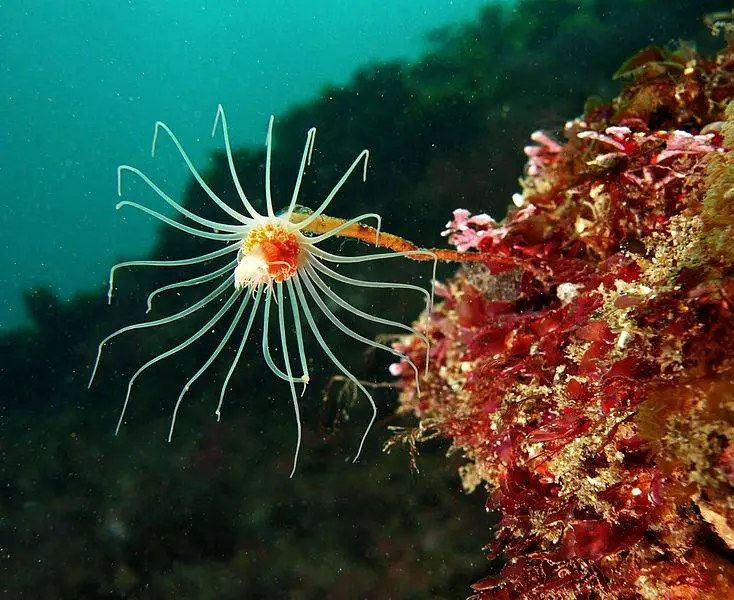After carefully planning your reef tank and choosing the perfect plants and livestock, it can be unbelievably frustrating to find uninvited guests. Hitchhikers, which are pests that come in with living rocks, plants, or corals, are some of the most unavoidable potential inhabitants of your aquarium that you never want to see. One of the most annoying creatures that can show up in your reef tank is hydroids.
Hydroids, also known as digitate hydroids, are tiny animals in the same family as jellyfish that can show up in any reef tank and cause chaos. Even worse, these pests can often bloom in newer tanks, which can discourage new tank keepers. Thankfully, there are solutions to a hydroid problem if you are diligent.
Often smaller than a pinhead, and with the ability to sting tank livestock, hydroids can be frustrating and even dangerous if large enough numbers. The fact that they are so prevalent in the aquarium hobby is both a blessing and a curse, because although you’re likely to get them in your reef tank at least once, we know enough about them to eradicate them. Let’s look a little deeper into what hydroids are in reef tanks, and what can be done about them.
What Eats Hydroids in a Reef Tank?
If you want to go down the more natural route when ridding your tank of hydroids, there are plenty of creatures that enjoy them for a quick snack. Most fish don’t enjoy eating hydroids, so it’s important to not rely on your normal tank dwellers for hydroid clean up. Instead, turn to one of the hydroid eating specialists: Flameback Angelfish, Pteraeolidia Lanthina, and the Lynx Nudibranch.
The first animal that eats hydroids in a reef tank is the Flameback Angelfish. The Flameback Angelfish, also known as the Pygmy Angelfish, will prey on hydroids if they become hungry enough.
These angelfish may have shorter fins than some other angelfish, but they make up for it with their brilliant orange and blue coloring and willingness to eat pests like hydroids in the tank. If your hydroid problem isn’t out of control, and you’ve noticed your Flameback hunting before, they may be the perfect weapon against hydroids.
The other two big eaters of hydroids are the Pteraeolidia Lanthina and the Lynx Nudibranch. Both of these creatures are types of Nudibranchs, which are sea slugs. The Lynx is particularly effective in eating hydroids, but they are reluctant to eat other foods, so keep an eye on your slug to make sure it doesn’t starve.
If using these creatures to clear your hydroid problem doesn’t work, you may have to look into chemical methods of destroying these pests.
Are Hydroids Bad in a Reef Tank?
While hydroids aren’t dangerous to all other inhabitants of reek tanks, they aren’t exactly a good thing. Digitate hydroids are incredibly small, but even at this size they can sting. The sting of a hydroid isn’t anything for a human to worry about, but on a smaller fish, the stings can be debilitating.
Hydroid’s also tend to explode in numbers very swiftly, and while one sting is bothersome, dozens of stings can mean disaster for some fish. Hydroids are bad in a reef tank, because they can cause suffering to fish and other animals in your tank and take nutrients away from corals and plants. A hydroid bloom can resolve on its own, but it’s a good idea to have a plan in mind in case you aren’t so lucky.
Hydroids mostly feed on plankton, so when they sting a fish or another creature, it is a warning sign. Hydroids are very simplistic animals, like a jellyfish, and these stings allow them to protect themselves passively, so they can free float and eat without being bothered. If you don’t have any tank livestock that will eat your hydroids, you’ll need to look into other eradication options.
How Do I Get Rid of Hydroids in My Reef Tank?
Getting rid of hydroids isn’t too difficult, but it’s important to thoroughly research whatever methods you use, because some can be toxic to fish or invertebrates in your tank. There are 3 primary methods for removal that have high success rates: manual removal, hydrogen peroxide, and fenbendazole.
Manual removal is the most time-consuming method to get rid of hydroids in a reef tank, since you will have to remove the hydroids one by one with a pair of tweezers. Be careful not to touch them with your hands and grab them by the body for removal. If you grab the hydroids by the legs, the legs may just detach and the hydroid will escape.
Hydrogen peroxide will kill hydroids, but it also does damage to the beneficial bacteria in your tank. Fenbendazole is the most effective treatment for heavy outbreaks of hydroids, but be careful when using it with invertebrates. Fenbendazole also will kill any worms, like detritus worms, in your tank, and these decomposing worms can cause an ammonia spike if not removed.
How Do You Treat Hydroid Stings?
Hydroids, as small as they are, can still sting humans, causing a stinging and burning sensation. If you’re cleaning your reef tank and end up with a painful sting, there are a few steps you need to follow to get rid of the pain, and fast. Hydroid stings aren’t dangerous to humans, but they can still be bothersome.
To treat hydroid stings, rinse the affected area with white vinegar. The acetic acid in the vinegar destroys and removes the part of the stinger from the hydroid that remains in your skin, called nematocysts. White vinegar works best, but we can use apple cider vinegar in a pinch.
If the itching and stinging sensation persists after washing the area in vinegar, you can use other topical medications like cortisone cream. We can use oral allergy medications like diphenhydramine and cetirizine as well, but they may take longer to work. If the discomfort lasts for more than a day, call your doctor.


